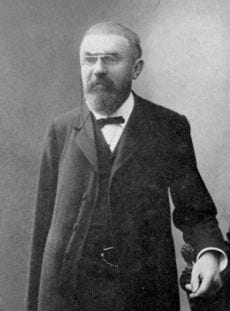Finding Order In Chaos

Life is unpredictable, there are billions of events that go unnoticed but can have an unprecedented impact on the world. However if noticed carefully we can see patterns determining them. Throughout history, researchers have attempted to recognize various principles that depict, for instance, the movement of pendulums and planets revolving around stars.
However, the explanations for other events, such as changes in the climate, abrupt changes in weather,decomposition and demographic changes in various species, seemed impossible. For centuries, these complex systems were classified as random.
The truth is that they were not, but the necessary mathematics were not available to understand their patterns, until the emergence of chaos theory. In fact,many phenomena of nature are governed by physical laws that allow their changes to be predicted.
One of the main architects of the new chaos theory was Henri Poincaré (29 April 1854–17 July 1912), a French mathematician who made many fundamental contributions to pure and applied mathematics, mathematical physics, and celestial mechanics. In his research on the three-body problem, Poincaré became the first person to discover a chaotic deterministic system which laid the foundations of modern chaos theory. He is also considered to be one of the founders of the field of topology.

In 1887, Poincaré participated in a problem-solving competition held on the occasion of the birthday of King Oscar II of Norway and Sweden. The problem was to describe the position of the planets in the solar system at each past and future moment of time, following the model of Newton’s equations. Poincaré identified the unpredictability of the system and wrote:
‘It may happen that small differences in the initial conditions produce very great ones in the final phenomena. A small error in the former will produce an enormous error in the latter. Prediction becomes impossible.’
Poincaré only gave a partial solution to the problem, yet received the award.
The Butterfly Effect

Edward Norton Lorenz came across the study of dynamic systems while he was studying climate. He wanted to repeat one of the simulations, but he chose the intermediate data of the result of the first computation as the initial conditions of the second.
The computer used six decimals during the calculations, but rounded off to three on the printed result, which was the one used by Lorenz. Lorenz thought, the difference between the data to three or to six decimals is less than 0.0001, so the results of the second run should have been very similar to those of the first.
Later he found, the two climatic predictions given by the model took completely separate paths. After ruling out mechanical fallacies in the computer, Lorenz came to the same conclusion as Poincaré: the properties of the system meant that small changes in the initial conditions led to significantly different results.
This gave rise to the famous talk :
Does the flap of a butterfly’s wing in Brazil set off a tornado in Texas?
Later he coined this phenomena as the “Butterfly Effect”
Smale’s Horseshoe Map
Fast forward to 1960 ,where a mathematician, Stephen Smale was thinking about a problem inspired by the math of radio waves. The complexity of the problem worried him, especially since he had previously conjectured that there was no such thing as chaos.
“I made some pretty bad predictions,” he says. “ Levinson at MIT pointed out that there were these old papers by a pair of English mathematicians. They had interesting results which contradicted what I had predicted, and I wanted to understand what they did. So I put what I did in a very geometric context so I could understand it.”
The result is now know as Smale’s horseshoe map. It beautifully encapsulates how chaotic dynamics can arise in mathematics and goes straight to the heart of the problems Poincaré had encountered when thinking about his three-body problem. “Poincaré got a big mess, and the horseshoe put order in the mess.”

Transition From Order to Chaos
During the 1970s, Mitchell Feigenbaum, a physicist, discovered a fundamental way of the transition .Using the power of computation, he demonstrated the existence of a constant that appears in a broad class of mathematical functions before the onset of chaos. This number, around 4.669, is known as the Feigenbaum Constant.
In the mid-1980s, chaos was a booming topic.Mathematicians, astrophysicists, engineers, computer scientists, meteorologists, philosophers, sociologists, anthropologists and economists began to see beyond the apparent random disorder of nature, finding connections in the behavior of meteorological phenomena, financial markets, the movement of certain celestial bodies, the evolution of ecosystems.
The chaos theory became the perfect tool for extracting order out of the seemingly chaotic nature of various elements.
It is based on two core ideas:
Even complex systems contain an underlying order
In such systems, small differences in initial conditions produce very divergent results.
Such dynamic systems occur, even though the behavior of these phenomena is completely determined by their initial conditions, without involving any type of random elements. Therefore, deterministic nature of these systems does not make them predictable, although, wit the help of the chaos theory it is possible to analyze their unpredictability from a strategic perspective.
